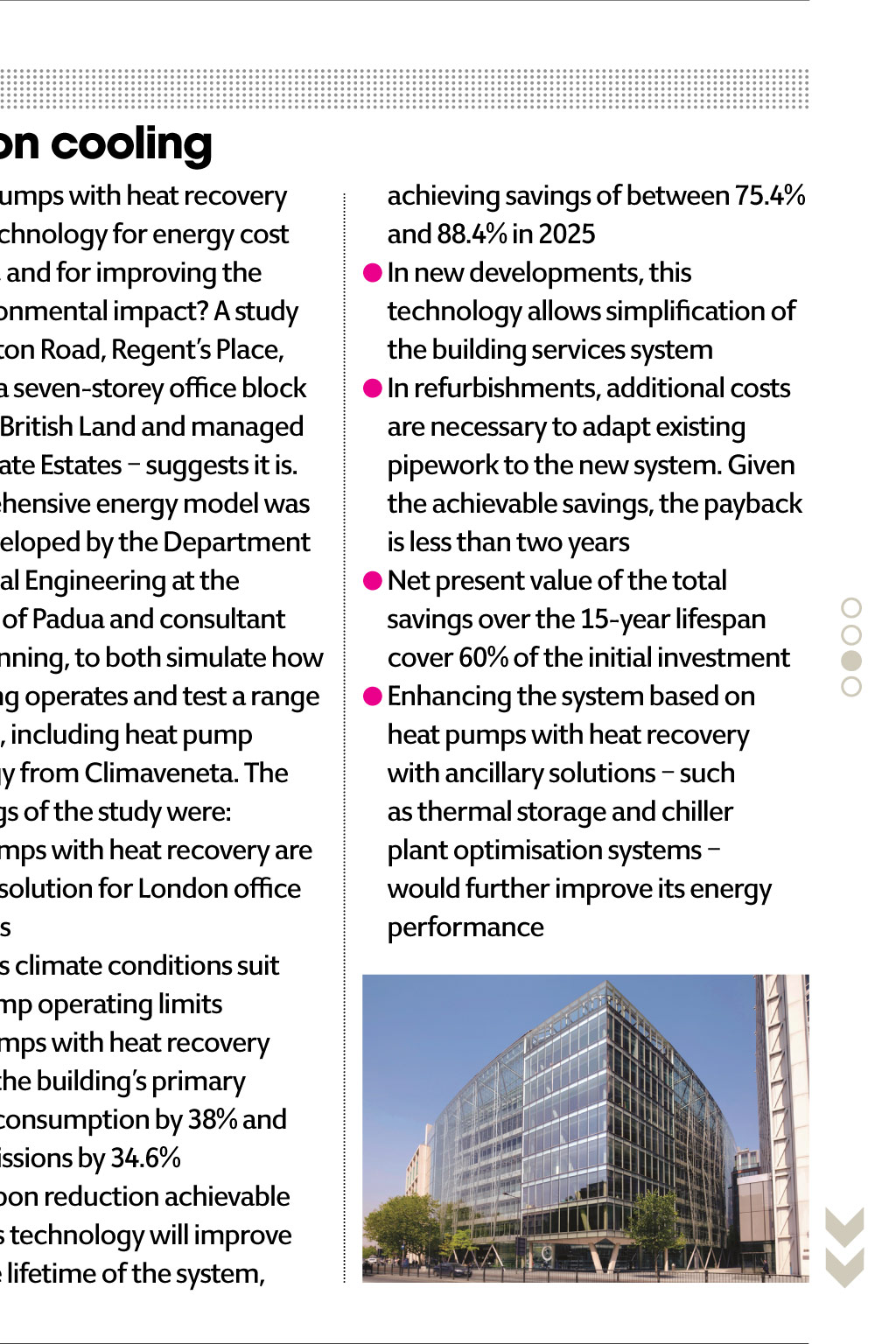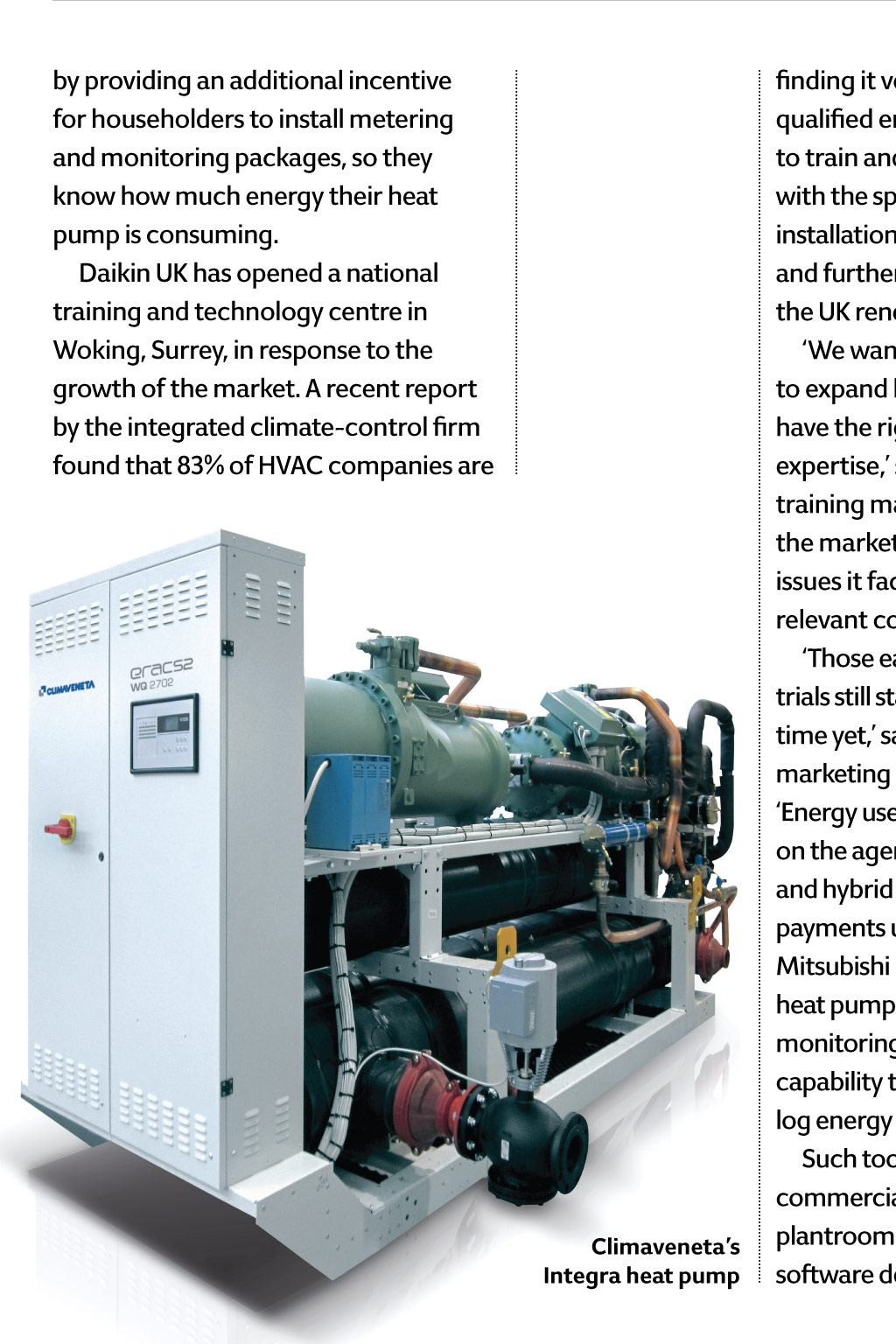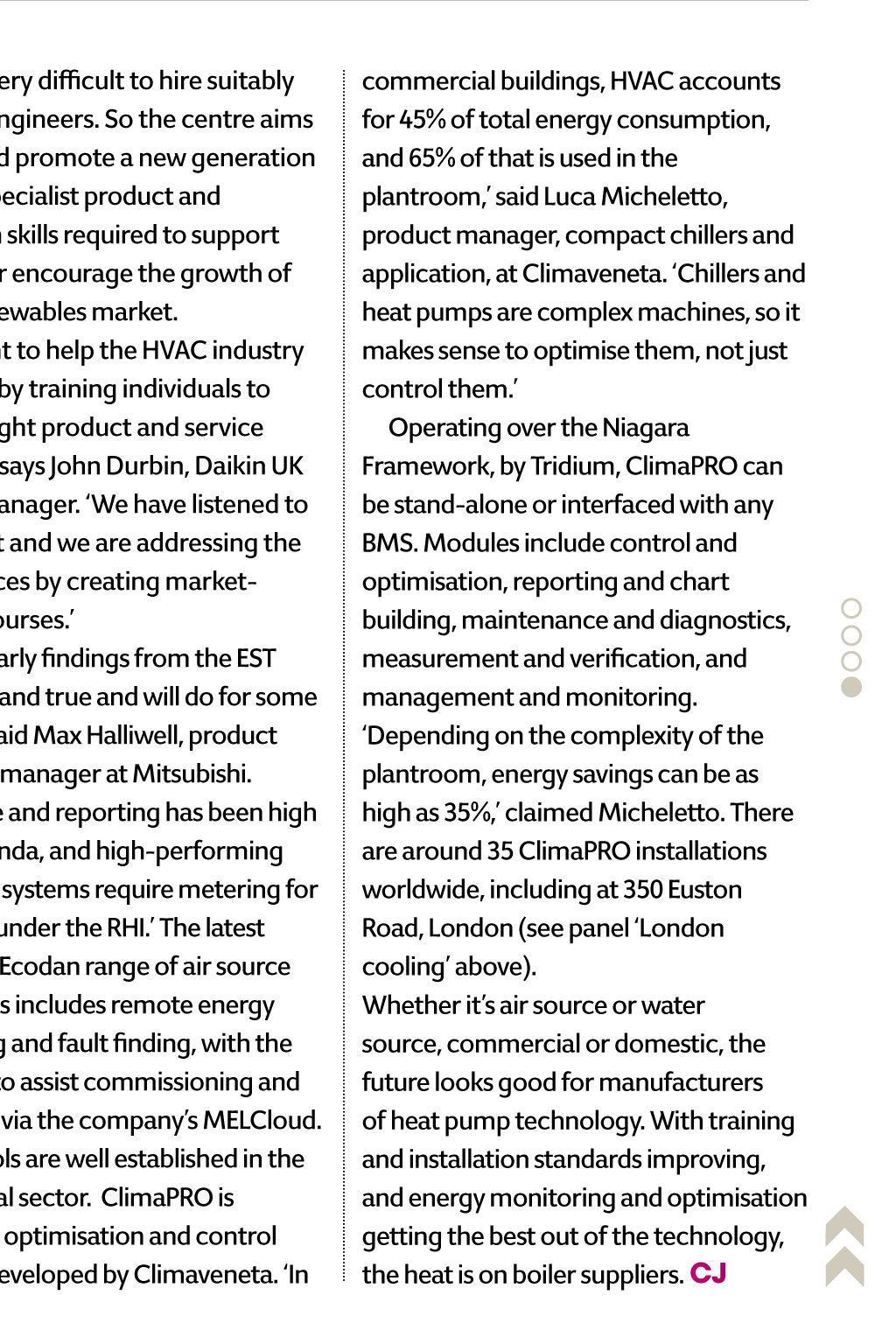
















HEAT PUMPS mArkET ovErvIEW Daikins new national training and technology centre in Surrey puMp up the vOlumE The government predicts a massive uptake in heat pump technology as the UK looks to accelerate growth in renewable energy. Andrew Brister looks at themarket drivers and howthe industry is tackling skills shortages, installation issues and optimisation of the technology O ne million homes could be tapping into renewable heat hidden in our waterways. The Conservative-Liberal Democrat coalition government launched The Water Source Heat Map an interactive, online tool produced by Buro Happold that reveals the 4,000 rivers, estuaries, canals and coastal sites across the UK that, together, could provide more than 6GW of low-carbon heat to communities. By installing a water source heat pump, people can help eliminate the need for gas-fired domestic heating and a typical household could slash its carbon footprint by up to 50%. Launching the map at Battersea Power Station, in London, in March, the energy and climate change secretary, Ed Davey, said: We need to make the most of the vast amount of clean, renewable heat that lies dormant and unused in our rivers, lakes and seas. Doing this will help contribute to an energy mix that maximises clean, reliable, home-grown resources rather than relying on foreign fossil fuels. It also provides a system that bolsters growth in our local economies, protects the natural environment and creates resilient communities capable of The projected rise in demand for domestic heat pumps in the UK prompts the question about whether there are sufficient installers with the necessary skills producing sustainable power systems. Battersea Power Station Development Company has announced that it is looking to install a water source heat pump at the site and that energy firm SSE will carry out a full feasibility study. The company will also investigate the re-use of the power stations existing engineering infrastructure, built 80 years ago to connect it to the Thames when the station was generating power. If a heat pump is installed, it would be one of the energy sources used to provide heat to around 4,000 new homes, shops, offices and public amenities being planned at the site. The Water Source Heat Map provides developers and homeowners with information to help them get water source heat pump projects up and running. It includes details of water conditions, such as temperature and flow rates, as well as the potential heat capacity of each waterway, and coming years. It shows demand for domestic air source heat pumps rising from 1 TWh/y in 2015 to 8 TWh/y in 2020 and a huge 85 TWh/y by 2030. The domestic RHI is now in place to help facilitate the required market growth into the 2020s, where massmarket take-up will be required, said John Kellett, general manager, heating systems, at Mitsubishi Electric. The growth opportunities remain very compelling for renewable domestic heating in the UK as an industry, we must continue to prepare for massmarket adoption of the technology. Such a dramatic rise in demand prompts the question about whether there are sufficient installers with the necessary skills. The findings from early heat pump field trials conducted by The Energy Saving Trust (EST) between 2008 and 2013 have led to improvements in the Microgeneration Certification Scheme (MCS) installation standards, and the Department of Energy & Climate Change (DECC) and EST are continuing to work with industry and the MCS to further improve standards and training. DECC has also incorporated lessons learned from the trial into its design of the domestic RHI policy for example, the heat demand across England thus eliminating the cost and time it would take developers to do exploratory studies. As well as the map, the government has published a flow chart to help people navigate the process of setting up a water source heat pump. It has also worked with the Environment Agency to make it easier and quicker for people to apply for permits, and a code of practice on surface water heat pumps will be published this summer. The Renewable Heat Incentive (RHI) is one of the mechanisms government has used to encourage the take-up of heat pump technology, both water source and air source. In the commercial sector, the vast majority (94%) of applications under the RHI tend to be for biomass boilers, with heat pumps represented in only 2% of the 11,673 schemes from November 2011 to February 2015. The domestic RHI scheme has had a more enthusiastic take-up: of the 28,168 applications up to February 2015, 39% are for air source heat pumps and a further 16% for ground source ones. The Conservative-Liberal Democrat governments Carbon Plan projects a massive growth in the market in the London cooling Are heat pumps with heat recovery a viable technology for energy cost reduction, and for improving the UKs environmental impact? A study at 350 Euston Road, Regents Place, London a seven-storey office block owned by British Land and managed by Broadgate Estates suggests it is. A comprehensive energy model was jointly developed by the Department of Industrial Engineering at the University of Padua and consultant Studio Planning, to both simulate how the building operates and test a range of options, including heat pump technology from Climaveneta. The key findings of the study were: Heat pumps with heat recovery are a viable solution for London office buildings Londons climate conditions suit heat pump operating limits Heat pumps with heat recovery reduce the buildings primary energy consumption by 38% and CO2 emissions by 34.6% The carbon reduction achievable with this technology will improve over the lifetime of the system, by providing an additional incentive for householders to install metering and monitoring packages, so they know how much energy their heat pump is consuming. Daikin UK has opened a national training and technology centre in Woking, Surrey, in response to the growth of the market. A recent report by the integrated climate-control firm found that 83% of HVAC companies are Climavenetas Integra heat pump achieving savings of between 75.4% and 88.4% in 2025 In new developments, this technology allows simplification of the building services system In refurbishments, additional costs are necessary to adapt existing pipework to the new system. Given the achievable savings, the payback is less than two years Net present value of the total savings over the 15-year lifespan cover 60% of the initial investment Enhancing the system based on heat pumps with heat recovery with ancillary solutions such as thermal storage and chiller plant optimisation systems would further improve its energy performance finding it very difficult to hire suitably qualified engineers. So the centre aims to train and promote a new generation with the specialist product and installation skills required to support and further encourage the growth of the UK renewables market. We want to help the HVAC industry to expand by training individuals to have the right product and service expertise, says John Durbin, Daikin UK training manager. We have listened to the market and we are addressing the issues it faces by creating marketrelevant courses. Those early findings from the EST trials still stand true and will do for some time yet, said Max Halliwell, product marketing manager at Mitsubishi. Energy use and reporting has been high on the agenda, and high-performing and hybrid systems require metering for payments under the RHI. The latest Mitsubishi Ecodan range of air source heat pumps includes remote energy monitoring and fault finding, with the capability to assist commissioning and log energy via the companys MELCloud. Such tools are well established in the commercial sector. ClimaPRO is plantroom optimisation and control software developed by Climaveneta. In commercial buildings, HVAC accounts for 45% of total energy consumption, and 65% of that is used in the plantroom, said Luca Micheletto, product manager, compact chillers and application, at Climaveneta. Chillers and heat pumps are complex machines, so it makes sense to optimise them, not just control them. Operating over the Niagara Framework, by Tridium, ClimaPRO can be stand-alone or interfaced with any BMS. Modules include control and optimisation, reporting and chart building, maintenance and diagnostics, measurement and verification, and management and monitoring. Depending on the complexity of the plantroom, energy savings can be as high as 35%, claimed Micheletto. There are around 35 ClimaPRO installations worldwide, including at 350Euston Road, London (see panel London cooling above). Whether its air source or water source, commercial or domestic, the future looks good for manufacturers of heat pump technology. With training and installation standards improving, and energy monitoring and optimisation getting the best out of the technology, the heat is on boiler suppliers. CJ